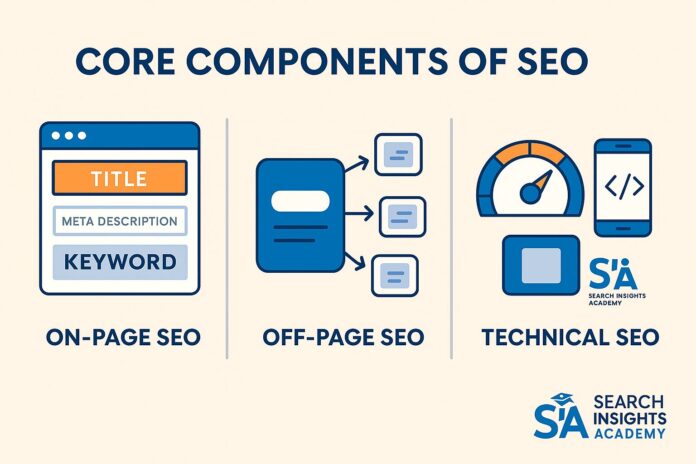Ever noticed how some websites always seem to dominate the top spots on Google? Meanwhile, your own site struggles to get noticed in the vast digital landscape? You’re definitely not alone. In this comprehensive guide SEO 101, we’ll break down how Search Engine Optimization (SEO) actually works, why it matters for businesses of all sizes, and the core components that can transform your online presence.
We’ll start with the fundamentals of how search engines crawl and index web pages, then explore both on-page and off-page SEO strategies. You’ll also discover how to find those valuable “low-hanging fruit” keywords that can boost your rankings without fighting impossible battles. By the end, you’ll understand not just why SEO is crucial for business growth, but also how to implement it step by step.
Whether you’re running a small local business or managing a large e-commerce site, these insights will help improve your visibility and drive more qualified traffic to your website. Ready to dive into the world of SEO? Let’s get started!
Introduction to SEO 101
When people ask, “What is SEO?” they’re really wondering how to get their website discovered on Google, Bing, or other search engines. Search Engine Optimization isn’t some mysterious dark art—it’s about making strategic changes to your website so it becomes more visible and appealing to search engines.
What Is SEO (Search Engine Optimization)?
SEO stands for Search Engine Optimization. It involves optimizing your website content, structure, and backlinks so search engines can effectively crawl, understand, and rank your pages. According to a study by BrightEdge, organic search drives 53% of all website traffic, making SEO one of the most cost-effective methods for bringing new customers to your digital doorstep.
Why Is Search Engine Optimization Important to a Business?
SEO significantly improves your brand awareness by helping you rank higher for keywords your potential customers search for daily. While traditional marketing casts a wide net, SEO targets users who are actively searching for products or services like yours. This is why businesses across the globe, from small startups in Sydney to multinational corporations in New York, increasingly prioritize SEO as a core part of their marketing strategy.
SEO vs Traditional Marketing
When comparing SEO to traditional marketing techniques, SEO typically offers better long-term value. Unlike paid ads that stop generating leads the moment you stop paying, SEO can deliver results for years once you’ve built a strong foundation. Research from Kapost shows that content marketing—a key aspect of SEO—costs 62% less than traditional marketing while generating about 3 times as many leads. That said, most successful businesses combine SEO with other marketing channels for maximum impact.
Core Components of SEO
The core components of SEO include on-page, off-page, and technical elements that work together to boost your website’s visibility. Understanding how these three pillars complement each other is crucial for developing a comprehensive SEO strategy.
On-Page SEO Fundamentals
On-page SEO focuses on optimizing individual web pages to rank higher and earn more relevant traffic. This includes strategically placing keywords in titles, headings, and content, but it’s far more than just keyword stuffing. According to Searchmetrics’ ranking factors study, content relevance and comprehensiveness are among the most important factors for ranking well.
Modern on-page SEO also involves creating content that addresses user intent, structuring information with proper HTML headings, and ensuring your content is easily scannable and digestible.
Off-Page SEO Strategies
Off-page SEO builds your site’s authority through external signals like backlinks, which act as votes of confidence from other websites. A study by Backlinko analyzing over 11 million Google search results found that the number of domains linking to a page correlated with rankings more than any other factor.
But it’s not just about quantity—quality matters tremendously. A few links from reputable industry websites carry more weight than dozens from obscure blogs. Other off-page factors include brand mentions, social signals, and local citations, all contributing to how search engines perceive your site’s credibility.
Technical SEO Best Practices
Technical SEO ensures your website is accessible to search engines and provides a great user experience. Google’s Page Experience update confirmed that user experience metrics like page speed, mobile-friendliness, and secure connections (HTTPS) directly impact rankings.
Tools like Google’s PageSpeed Insights can help identify technical issues slowing your site down. Other technical elements include implementing structured data (Schema markup) to help search engines better understand your content, creating XML sitemaps, and ensuring your site has a logical structure that search engines can easily crawl.
Choosing & Using the Right Keywords
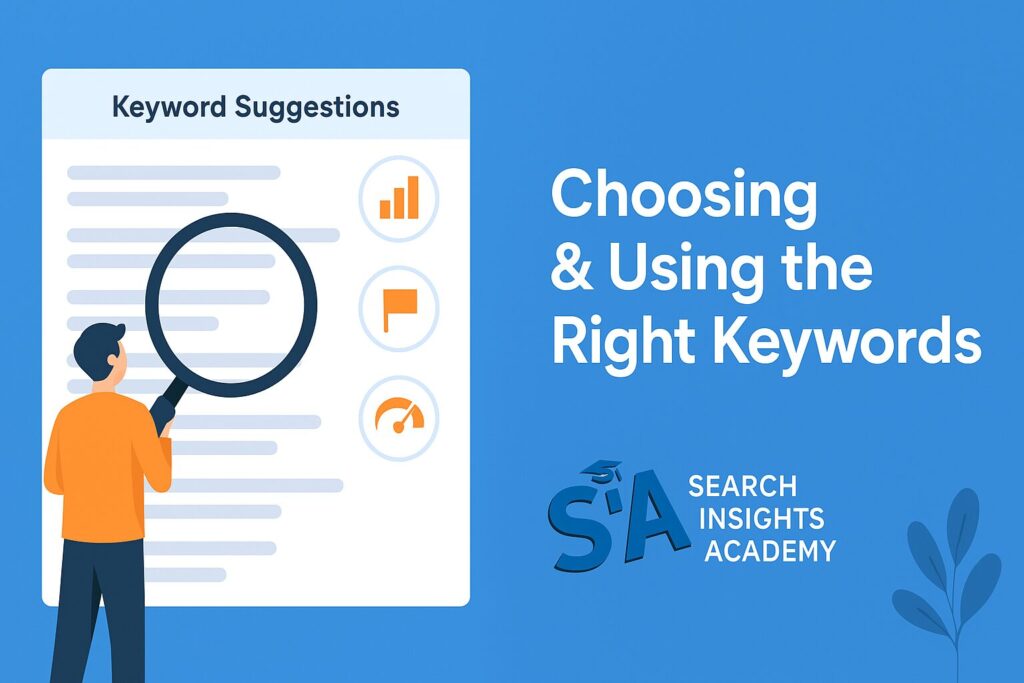
For many SEO beginners, keyword research feels overwhelming, but it’s actually one of the most straightforward aspects once you understand the fundamentals. Selecting the right terms to target can dramatically simplify your SEO efforts.
Why Keywords Matter for Website SEO Optimization
Keywords connect searchers with your content. When someone types a query into Google, the search engine works to match their intent with relevant pages. According to research by Ahrefs, nearly 68% of online experiences begin with a search engine, making keywords crucial for capturing potential customers at the exact moment they’re looking for something you offer.
Different industries have vastly different keyword landscapes—what works for a restaurant in Melbourne will differ from what works for a software company in Toronto. Understanding your specific market’s search patterns is essential to SEO success.
Identifying Low-Hanging Fruit Keywords
“Low-hanging fruit” keywords are relatively easy to rank for while still driving valuable traffic. Tools like Ubersuggest or Ahrefs Keywords Explorer can help identify terms with decent search volume but lower competition.
For example, a new fitness equipment store might struggle to rank for “best treadmill” (high competition) but could quickly gain visibility for “best compact treadmills for small apartments” (lower competition but still relevant to their business). These specific, longer phrases—known as long-tail keywords—often convert better because they target users with clear intent.
How to Use Keywords Effectively
Modern keyword usage is all about context and relevance. Search Quality Rater Guidelines from Google emphasize that content should demonstrate E-E-A-T (Experience, Expertise, Authoritativeness, and Trustworthiness) rather than just keyword density.
Place keywords naturally in your title tags, headers, opening paragraphs, and throughout your content. But always prioritize readability and user experience. A good rule of thumb: if reading your content aloud sounds awkward because of keyword placement, it needs revision. Remember that Google’s algorithms have become sophisticated enough to understand synonyms and related concepts, so focus on covering topics thoroughly rather than repeating exact keyword phrases.
On-Page SEO in Practice
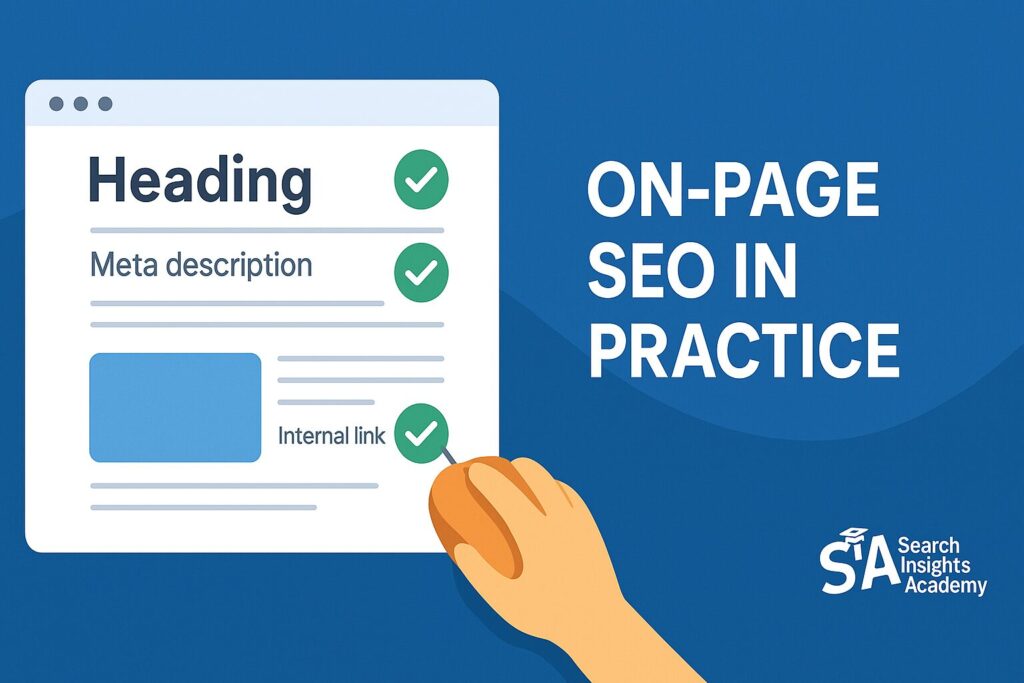
“How do you actually do SEO?” is a common question, especially from business owners just getting started. On-page SEO involves much more than sprinkling keywords throughout your content—it’s about creating a cohesive, valuable experience for both users and search engines.
How to Do SEO for a Website (Step by Step)
Start with comprehensive keyword research to understand what your audience is searching for. Use tools like Google Keyword Planner or SEMrush to identify relevant terms with reasonable search volume.
Next, create or optimize content around these terms, ensuring you address the user’s search intent. According to Content Marketing Institute, the most successful SEO content answers specific questions and provides genuine value.
Structure your pages with clear headings (H1, H2, H3) and short paragraphs for readability. Include internal links to guide visitors to related content on your site, and don’t forget to optimize images with descriptive alt text and compressed file sizes.
How Do You Do SEO? (Common Pitfalls & Tips)
One major pitfall is focusing on short-term tricks rather than sustainable strategies. Google’s history of algorithm updates shows that sites trying to game the system eventually get penalized.
Another common mistake is neglecting mobile optimization. With mobile devices generating over 60% of search traffic, having a responsive design isn’t optional anymore—it’s essential.
The best tip? Create content for humans first, search engines second. Neil Patel’s research shows that user engagement metrics like time on page and bounce rate indirectly influence rankings, so focus on keeping readers engaged with valuable, well-presented information.
Understanding “SEO Your Website” and Content Relevance
When marketers talk about “SEO-ing your website,” they mean optimizing the entire site so each page contributes to your overall search visibility. This holistic approach is more effective than trying to rank a single page in isolation.
According to research by Orbit Media, comprehensive content that thoroughly covers a topic tends to outperform shorter pieces. This doesn’t mean every page needs to be 2,000+ words—rather, it should completely satisfy the searcher’s query, whatever length that requires.
High-quality content that demonstrates expertise is especially important in industries like healthcare, finance, and education, which fall under Google’s YMYL (Your Money or Your Life) category. For these topics, Google holds content to higher standards because inaccurate information could potentially harm users.
Off-Page SEO & Technical SEO
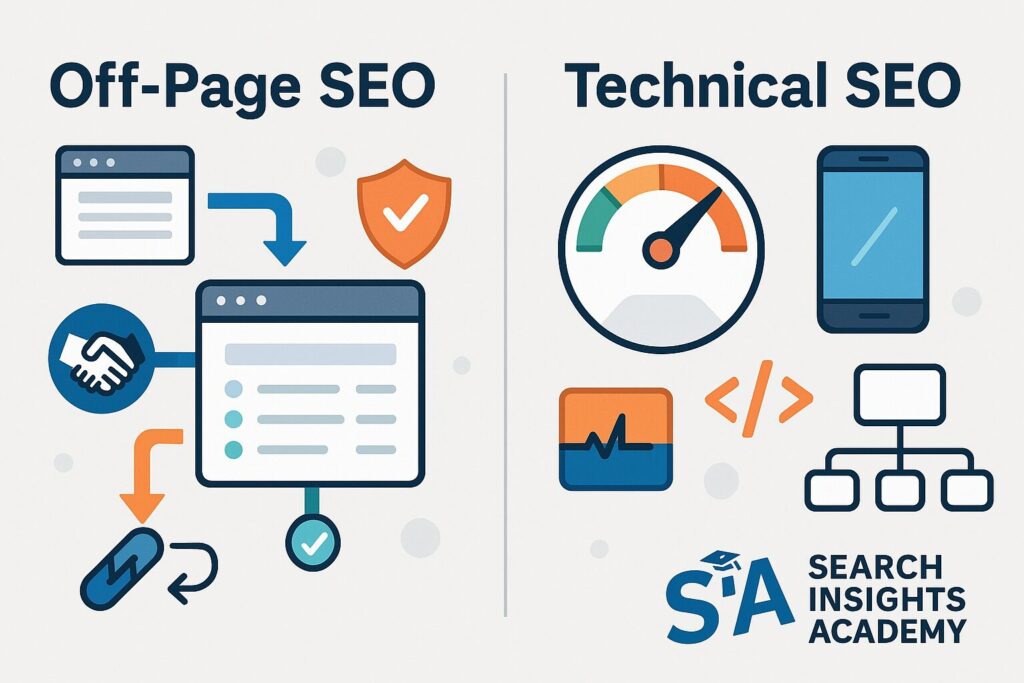
While on-page factors give you direct control, off-page and technical SEO elements often determine whether your site can compete for top positions. These components work together to build your site’s authority and ensure search engines can properly access and understand your content.
Building High-Quality Backlinks
Backlinks remain one of the most powerful ranking signals. A study by Stone Temple (now Perficient) found that links continue to have a strong correlation with higher rankings, even as search algorithms grow more sophisticated.
To build quality backlinks, focus on creating linkable assets—comprehensive guides, original research, infographics, or tools that naturally attract references. Content Marketing Institute reports that original research and data are among the most linked-to content types.
Outreach is another essential strategy. By connecting with industry publications, bloggers, and complementary businesses, you can build relationships that lead to natural link opportunities. Whether you’re a local business in Perth or a global brand in London, identifying relevant linking opportunities in your specific market is crucial.
Social Signals & Their Role in Site SEO Optimization
While social media engagement doesn’t directly impact rankings, Hootsuite’s research found that active social profiles can significantly increase brand visibility and indirectly support SEO through increased brand awareness and content distribution.
When content gets shared widely on social platforms, it reaches more people, potentially earning more backlinks and direct traffic—both positive signals to search engines. Successful businesses integrate their social media and SEO strategies, using each channel to reinforce the other.
Mobile Responsiveness & Site Speed in Web SEO Optimization
With Google’s shift to mobile-first indexing, having a mobile-friendly website isn’t just good practice—it’s essential. According to Google’s own research, 53% of mobile site visits are abandoned if pages take longer than 3 seconds to load.
Tools like Google’s Mobile-Friendly Test can quickly assess your site’s mobile performance. For speed optimization, consider implementing AMP (Accelerated Mobile Pages), compressing images, minimizing code, and leveraging browser caching. Technical improvements like these form the foundation upon which all your other SEO efforts build.
Local SEO & Performance Tracking
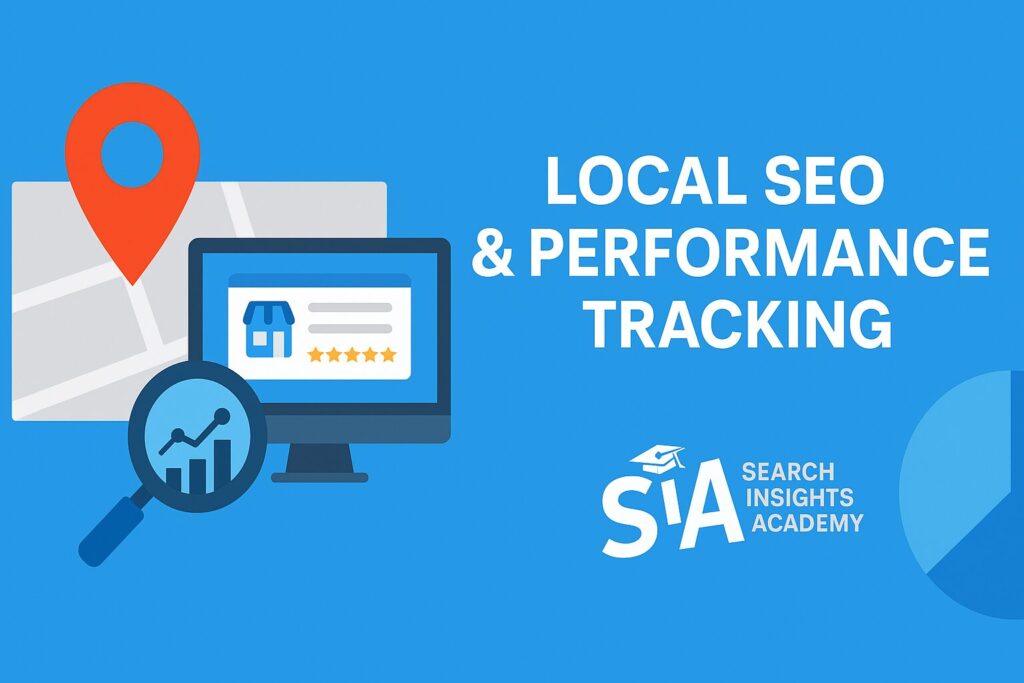
For businesses serving specific geographic areas, local SEO provides targeted visibility to nearby customers. Meanwhile, tracking and analytics help all businesses measure SEO success and identify opportunities for improvement.
Why Local SEO Is Important
For businesses with physical locations or service areas, local SEO can be even more valuable than general SEO. According to HubSpot, 46% of all Google searches have local intent, and Google reports that searches for “near me” businesses have grown exponentially in recent years.
Local SEO involves optimizing for location-specific keywords, building local citations (mentions of your business name, address, and phone number), and gathering reviews. Whether you run a café in Brisbane or a hardware store in Chicago, these strategies connect you with customers in your area who are ready to visit or buy.
Optimizing Google Business Profiles
Your Google Business Profile (formerly Google My Business) is perhaps the most important local SEO asset. A study by BrightLocal found that complete Business Profiles get 7x more clicks than incomplete ones.
Optimize your profile by:
- Adding accurate business information (hours, location, contact details)
- Selecting the correct primary and secondary categories
- Uploading high-quality photos (businesses with photos receive 42% more requests for directions)
- Responding to reviews (both positive and negative)
- Posting regular updates about offers, events, or news
For multi-location businesses, create and verify separate profiles for each location to maximize local visibility.
How to Improve SEO Through Analytics
Peter Drucker’s famous quote, “What gets measured gets managed,” applies perfectly to SEO. Tools like Google Analytics and Google Search Console provide crucial data about your website’s performance.
According to research by Databox, the most important metrics for tracking SEO success include:
- Organic traffic growth
- Keyword rankings
- Bounce rate and time on page
- Conversion rate from organic search
- Page load speed
Regular analysis helps identify underperforming pages, new keyword opportunities, and technical issues before they become major problems. By establishing baseline metrics and tracking changes over time, you can see which SEO efforts deliver the best results for your specific business.
SEO FAQs & Common Concerns
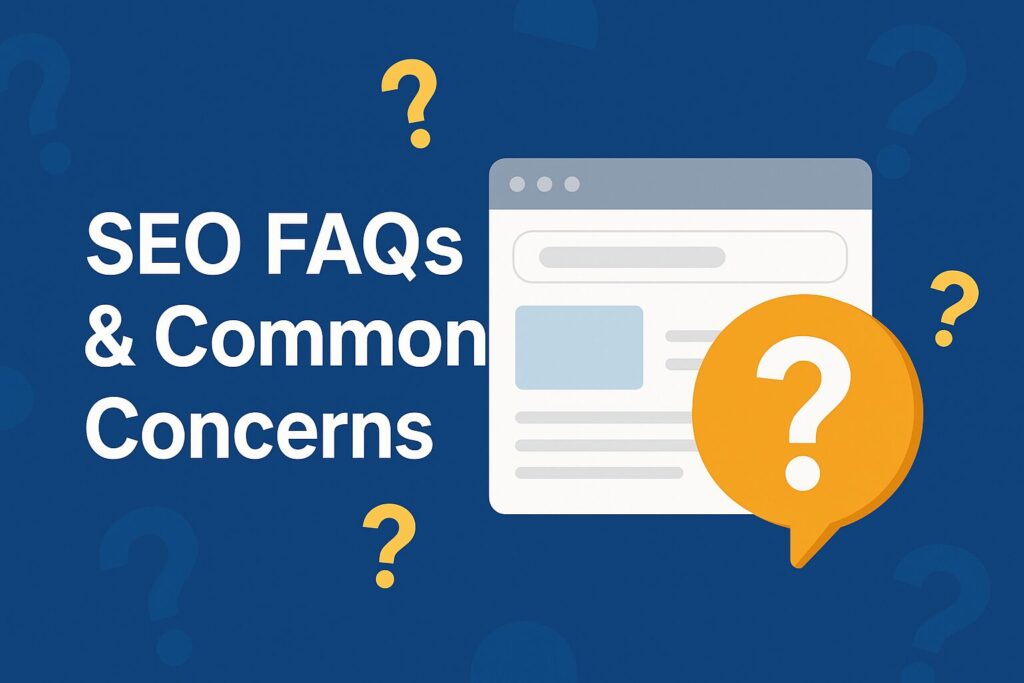
When exploring how to do search engine optimization, certain questions come up repeatedly. Let’s address these common concerns with practical, actionable information.
What SEO Do: The Real Impact on Visibility & Sales
SEO drives targeted traffic to your website, connecting you with people actively searching for your products or services. According to a study by Milestone Research, businesses can expect an average return of $22 for every $1 spent on SEO—among the highest ROIs in digital marketing.
This impact translates directly to business results. BrightEdge research shows that organic search traffic has an average conversion rate of 14.6%, compared to just 1.7% for outbound methods like print or direct mail advertising.
How to Do SEO Work & Why It Matters
SEO work involves ongoing optimization across multiple areas: keyword research, content creation, technical improvements, and link building. It’s both a science (using data to guide decisions) and an art (creating engaging content that satisfies both users and algorithms).
It matters because search engines drive the majority of online discovery. Internet Live Stats reports that Google processes over 3.5 billion searches daily—each representing a potential customer finding your business instead of a competitor’s.
Why Is Search Engine Optimization Important for Business?
Search engine optimization creates a level playing field where businesses of all sizes can compete for visibility. Unlike paid advertising, where the biggest budget typically wins, SEO rewards relevance, expertise, and quality—factors within any business’s control.
For small businesses especially, SEO represents an opportunity to reach customers without massive marketing budgets. A local plumber in Adelaide can outrank national chains for searches in their area by focusing on relevant local terms and building strong community connections.
How Do You SEO a New Website?
For new websites, focus first on technical fundamentals: ensure proper indexing, create a logical site structure, and implement basic on-page optimization. According to SEMrush’s study of ranking factors, these technical elements form the foundation for all other SEO efforts.
Next, create cornerstone content—comprehensive resources addressing the main topics relevant to your business. Content Marketing Institute research shows that new sites with fewer than 10 high-quality pages can rank well if those pages thoroughly address user needs.
Finally, begin building your site’s authority through guest posting, participating in industry forums, and creating shareable content that attracts natural links. Remember that SEO is a marathon, not a sprint—consistent effort yields compounding returns over time.
Why SEO Is Important: Key Benefits & Statistics
Beyond increased visibility, SEO offers several concrete benefits:
- Consistent ROI: While paid ads stop working the moment you stop funding them, SEO continues generating traffic with minimal maintenance once established.
- Consumer trust: 70-80% of users ignore paid ads and focus on organic results, perceiving them as more trustworthy.
- Mobile advantage: With mobile searches exceeding desktop, SEO-optimized sites capture traffic from on-the-go users.
- Local business impact: 76% of people who search for something nearby on their smartphone visit a business within a day, and 28% of these searches result in a purchase.
These benefits make SEO not just important but essential for businesses seeking sustainable growth in the digital age.
When implemented thoughtfully, SEO opens doors to new opportunities for your business. By focusing on essential elements like on-page optimization, strategic keyword research, technical structure, and quality link building, you create a foundation for lasting visibility in search results. Each improvement helps you outpace competitors, attract qualified leads, and build credibility with both search engines and customers.
Remember that SEO isn’t just about metrics—it’s about connecting the right people with your business at the exact moment they’re looking for what you offer. Whether you’re a local shop in Brisbane or a global e-commerce brand, the fundamental principles remain: create valuable content that addresses user needs, ensure technical excellence, and build meaningful connections within your industry.
The beauty of search engine optimization lies in its adaptability. As search algorithms evolve and user behaviors change, SEO professionals adjust their strategies accordingly. By staying informed about industry developments and consistently refining your approach, you position your business for sustainable growth through organic search.
Now that you understand the fundamentals of SEO, it’s time to take action. Start with an audit of your current site, identify the most pressing opportunities, and begin making improvements. The path to better visibility starts with a single optimization—and there’s no better time to begin than today.

